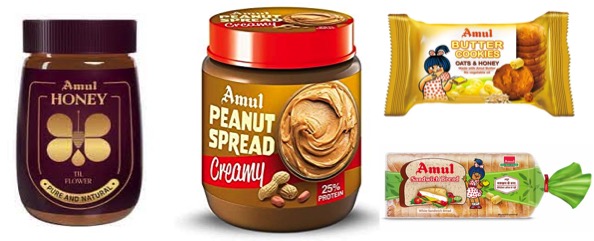In its 75th year, Amul literally appears to be in milk and honey land. Last month, India’s largest dairy company launched a new non-dairy product — Amul Honey. But this was no bee in the bonnet move. The Gujarat-based milk major, which clocked a turnover of over ₹53,000 crore in 2020-21; has been slowly foraying into the non-dairy foods segment.
Last year, Amul entered the edible oils segment with a new brand Janmay; and an announcement that it would pump in ₹500 crore on manufacturing facilities for new products. In 2019, it wedged itself into potato snacks. The brand has been expanding, getting into atta, ready-to-eat frozen snacks, sweets and more. The share of non-dairy products in overall revenue has grown from near-negligible to a high-single-digit, between 2010-2021.
However, RS Sodhi, Managing Director, Gujarat Cooperative Milk Marketing Federation Limited (GCMMF); which owns the brand Amul, asserts that the core focus remains on dairy.
The diversification is to take advantage of existing prowess in supply-chain and delivery infrastructure across geographies for value addition to farmer members who have other cultivations. As Sodhi points out, from milk to potato, anything sold under the brand yields additional earnings for farmer members.
Food for thought
In milk, Amul, which began its journey as a small co-operative union in 1946, looks unshakeable with its heritage, history and marketing muscle. But in foods, can it take on deep-pocketed MNCs and established Indian brands that have presence and brand recall? In chocolate, where Amul has been growing aggressively, it is competing against market leaders Mondelez (Cadbury) and Nestle. The edible oils segment is fairly crowded with Adani Wilmar, Cargill, Patanjali et al. In frozen foods, Amul competes with McCain, Godrej Agro, ITC and a host of start-ups.
But the way Amul has been chipping away at the chocolate segment, which it entered in 1973, shows it cannot be taken lightly. It ramped up chocolate capacity with a 1,000 metric tonne per month chocolate plant at Mogar village near Anand at ₹190 crore in 2018, and quickly shifted focus to dark chocolate, catering to shifts in customer preferences.
But while it has been flourishing at an average growth of 14.5 per cent over the past decade (although in the pandemic year, growth was clipped to 2 per cent, as the out-of-home segment was badly hit), there are challenges.
Amul has been the target of lobbyists trying to make a dent in the co-operative movement of milk. Take the veganism controversy and the emergence of competition from dairy analogues — a substitute of real milk fat with cheaper ones made from vegetable fat. Sodhi is unfazed. He says, “Competition is good, it brings efficiency in the system and better prices for farmers. And veganism is a fad, there is no threat.”
Turning points
Set up to counter the monopolistic practices of Polson dairy, Amul’s first big break came when Dr Verghese Kurien helped it develop milk powder from buffalo milk in the early 1950s. This helped it get an edge over Nestle. Subsequently, it deployed cheese and baby foods too. This cemented Amul’s resolve to use technology for innovation, efficiency and profitability.
The second turning point was the GCMMF formation in 1973. All district-centric milk producing co-operative unions came under one State-level marketing organisation. This gave a unified identity and cost rationalisation for products. Today, Amul has over 50 products with more than 1,070 stock keeping units.
Third, in 2010-11, Amul started milk procurement from outside Gujarat. About 40 lakh litres of milk comes from other States, adding to the 210-230 lakh litres procured within Gujarat. From the initial 250 litres of milk, Amul now collects about 280 lakh litres per day during peak season. In the past decade, Amul has added over 6.5 lakh milk producer members in Gujarat and 7 lakh from outside taking the total membership base to over 40 lakh milk producers.
To manage the extra, Amul follows a sound investment strategy. “If procurement grows by 10 per cent annually, we have to invest about ₹1,000-1200 crore to accommodate additional quantities,” Sodhi explains. In the past decade, Amul has invested approx. ₹8,700 crore to ramp up processing capacities. It now has the installed processing capacity of 390 lakh litres per day.
Marketing muscle
Over the years, Amul’s growth has also come through a strong marketing strategy that has focussed on brand building . The iconic Amul girl is perhaps the most recalled mascot in India.
When out-of-home consumption was impacted last year, Amul was quick to come up with recipe-oriented promos that urged consumers to try restaurant-style dishes at home with Amul products along with a nostalgic television campaign.
The eighth largest dairy brand globally, has strong recall world over, too. It supplies to over 50 countries, though exports are still only about one per cent of turnover.
Sharing the philosophy of Amul’s journey, Sodhi says, “If a food company has to become ageless, they have to take care of two major stakeholders of the food supply-chain, i.e. grower and consumer. Amul is able to take care of both. Our strategy is value for many (farmers) and value for money (of consumers). That helps us strike the right balance.”
Source Hindu Business Line 24 Oct 2021 by Rutam Vora

